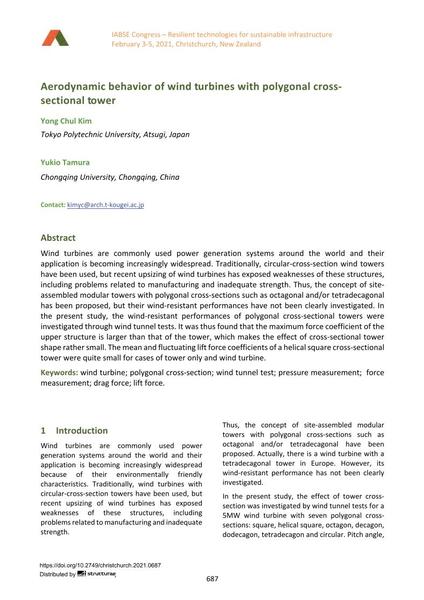Aerodynamic behavior of wind turbines with polygonal cross- sectional tower

|
|
|||||||||||
Bibliografische Angaben
| Autor(en): |
Yong Chul Kim
(Tokyo Polytechnic University, Atsugi, Japan)
Yukio Tamura (Chongqing University, Chongqing, China) |
||||
|---|---|---|---|---|---|
| Medium: | Tagungsbeitrag | ||||
| Sprache(n): | Englisch | ||||
| Tagung: | IABSE Congress: Resilient technologies for sustainable infrastructure, Christchurch, New Zealand, 3-5 February 2021 | ||||
| Veröffentlicht in: | IABSE Congress Christchurch 2020 | ||||
|
|||||
| Seite(n): | 687-694 | ||||
| Anzahl der Seiten (im PDF): | 8 | ||||
| DOI: | 10.2749/christchurch.2021.0687 | ||||
| Abstrakt: |
Wind turbines are commonly used power generation systems around the world and their application is becoming increasingly widespread. Traditionally, circular‐cross‐section wind towers have been used, but recent upsizing of wind turbines has exposed weaknesses of these structures, including problems related to manufacturing and inadequate strength. Thus, the concept of site‐ assembled modular towers with polygonal cross‐sections such as octagonal and/or tetradecagonal has been proposed, but their wind‐resistant performances have not been clearly investigated. In the present study, the wind‐resistant performances of polygonal cross‐sectional towers were investigated through wind tunnel tests. It was thus found that the maximum force coefficient of the upper structure is larger than that of the tower, which makes the effect of cross‐sectional tower shape rather small. The mean and fluctuating lift force coefficients of a helical square cross‐sectional tower were quite small for cases of tower only and wind turbine. |
||||
| Stichwörter: |
Windkanaluntersuchung Windkraftanlage
|
||||
